Campo’s Corner: Proof the scars of Super League still run deep for rugby league
We’re 25 years removed from Super League and the scars of rugby league’s civil war still show up when we talk about relocation or expansion writes NICK CAMPTON.
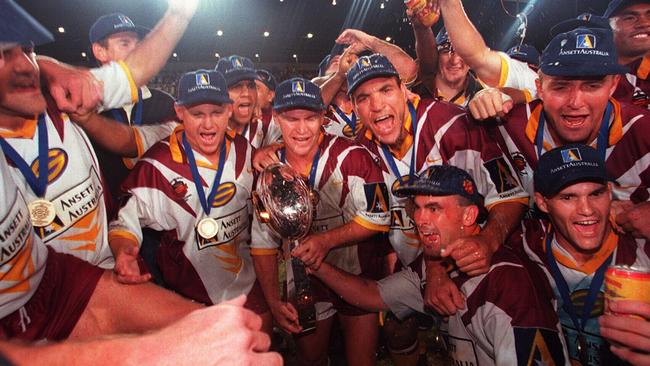
Teams
Don't miss out on the headlines from Teams. Followed categories will be added to My News.
BASHED: Yanks go crazy for Taufua’s hit
WILL HE PLAY: Will Farah take the field?
There’s a wonderful podcast called the Rugby League Digest which is currently undergoing a thorough retelling of the Super League War and it’s a must-listen for any footy fan with a fascination for the South Queensland Crushers, the Hunter Mariners and everything in-between.
It’s an extensive exercise — they’re seven episodes in and are only now getting to the infamous signing raids of April 1st, 1995. But this granular approach is not only comprehensive, but revealing — not just because of the details of the war, but of it’s causes and ongoing impact.
Stream the 2019 NRL Telstra Premiership on KAYO SPORTS. Every game of every round Live & On-Demand on your TV, computer, mobile or tablet. Get your 14 day free trial.

Super League tore the game apart because it played off the fundamental paradox of rugby league, which tries to be a billion-dollar, elite level sport and a community game at the same time.
Rugby league lives in a delicate balancing act between the Leichhardt Oval hill and the glittering Bankwest Stadium grandstands, between glitchy radio broadcasts and on-demand streaming, between sinking beers after the game and high performance athletic recovery.
When rugby league leans too far one way, it stagnates and seems impossibly small-time. Too far the other way and it becomes soulless, corporate and devoid of its original charms.
We’re a quarter of a century removed from Super League but it still looms so large over rugby league as a whole because it tried to abandon one of those arms. The pitch for the breakaway competition was State of Origin quality football every week, one franchise per big city or regional centre, making a suburban game cosmopolitan. The game’s ancient temples would be abandoned, sacrificed on the golden altar of the future.
Of course, such a plan underestimated people’s willingness and attachment to their traditions. Abandoning a club’s home of the past 70 years might make sense rationally, but rugby league is not a rational game. Memories are long, feuds are bitter and the scars of Super League still run deep, even a quarter of a century on until they’re ripped open and allowed to fester again, like they have been this week.
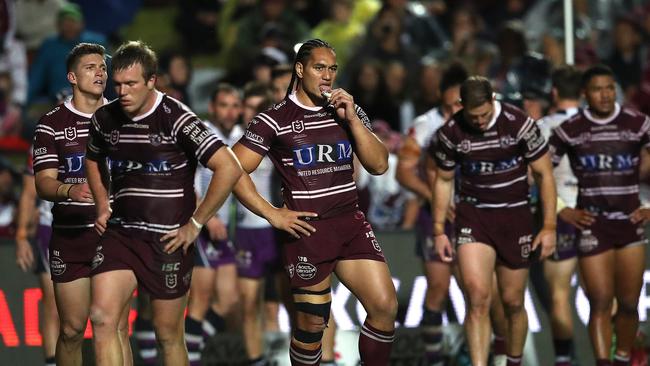
The Daily Telegraph broke the news on Sunday of Channel 9’s aim for a second Brisbane team to join the competition for the next broadcast deal, preferably through relocation of a Sydney club. With a lack of a concrete expansion plan by the NRL, a real failing of this administration, speculation runs wild with the usual suspects — Manly, Cronulla and Gold Coast, namely — coming into the firing line. It creates a secondary dialogue regarding the influence of broadcasters on the game. They provide the bulk of the money, so how often should they hold the whip?
These are difficult conversations to have, because no fan wants their club to move any less than they want them to merge, but also because there is still an aversion to any retraction of the competition which runs from the compromises and casualties of the Super League war.
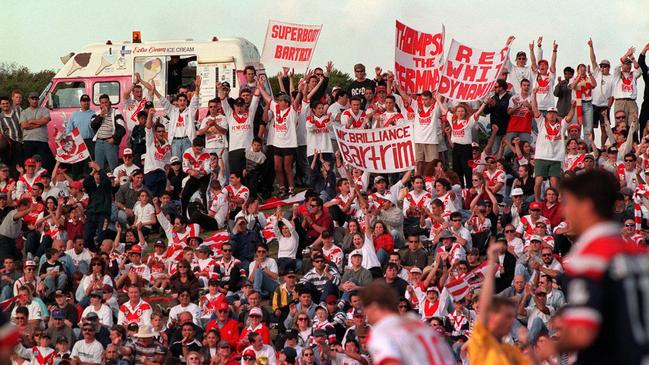
These conversations around contracting the number of Sydney clubs began even before Super League popped off, and manifested in decisions which now seem unthinkable. Balmain abandoned Leichhardt Oval at the end of 1994 and rebranded as the Sydney Tigers, playing out of Parramatta Stadium for two years.
Canterbury dubbed themselves the Sydney Bulldogs and Eastern Suburbs as the Sydney City Roosters in an effort to move beyond their suburban roots. A Roosters-Dragons merger was seriously discussed and nearly got over the line.
The post-war period was even more fraught with peril, as foundation clubs merged and expansion teams were pruned in an effort to reduce the bloated competition.
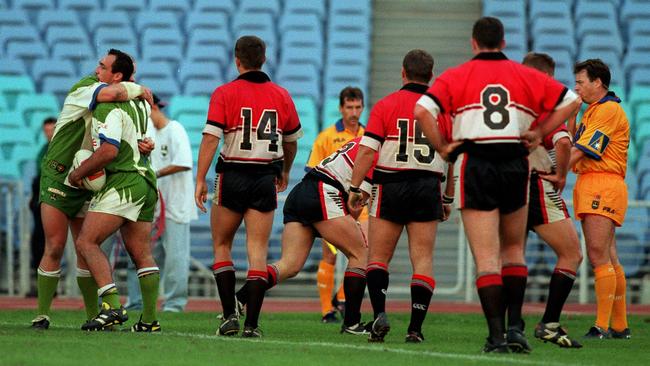
Many an old club were forced to merge, except for Souths who chose to fight and die and live again and therein lies the reason no club will walk away from their old home until it’s their only choice left. After years of conversations about rugby league’s glittering future, of which South Sydney were not a part, the Rabbitohs survived because of their tradition, their support and their links to the community. If a team got punted today like South Sydney were in 1999 it’s doubtful fans of every club would march as they did for the Bunnies, but the point remains valid — rugby league will never willingly abandon it’s suburban roots, even under pain of death.
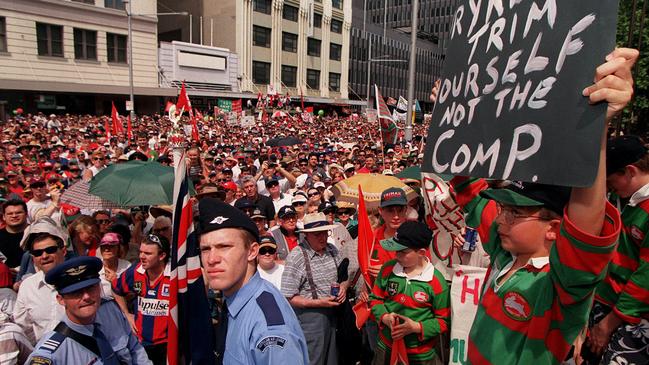
That’s not a bad thing necessarily — one of rugby league’s great strengths is it’s still a game you can reach out and touch. The rough edges make it easy to hold on, and sport at any level is at its best when it’s a community exercise. Look at the 18,000 people who were at PointsBet Stadium last week, or the similar crowd that will pack out Leichhardt this week. Rugby league has an unhealthy fear of progress, but days like that are part of what make the sport great.
Where that becomes a problem is the unwillingness for rugby league to expand its horizons, a task which often requires sacrifice. The Super League war and the years that followed created a psychic wound in the game, one which turned words like relocation and rationalisation and expansion into curses. The one time rugby league turned away from its tribal links it didn’t even turn all the way and the game was nearly destroyed. Now, for better or worse, those suburban origins are held close to the heart — we can’t move, and we never will, because this has always been our place, and it always will be.
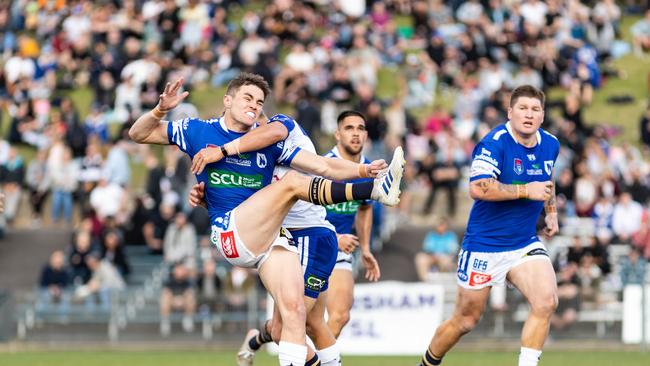
But there’s a sad truth behind that sentiment. Ask a Newtown fan or a Bears fan, or one of the old Magpie holdouts who never accepted the merger. History can’t keep a team alive forever, they need a future and a lot of the old places aren’t big enough to live on anymore.. The Rabbitohs rose from the dead on the shoulders of their past but, as anyone who watched them from 2002 to 2005 will tell you, that’s not enough to carry a team forever.
The Titans, perpetually crushed under the foot of clubs more powerful and hamstrung by their own ineptitude, don’t have any of this past or any of the confidence that comes from being old money. Many parties, apart from Gold Coast fans, would be satisfied if they became the South Queensland Titans and moved half their games to Brisbane. Doing so wouldn’t render the league’s sole expansion effort since Melbourne joined the competition a failure, but it would go pretty close and it would also be very shortsighted.
The Gold Coast-Tweed Heads area has the sixth highest population of any great metropolitan area in the country, that’s bigger than Canberra, Townsville, Wollongong and Newcastle. It’s too big a market with too many potential consumers to abandon completely - but calling a city a “market” and a fan a “consumer” conjours memories of “franchises”, “rationalisation” and “vision”, so it angries up the blood.
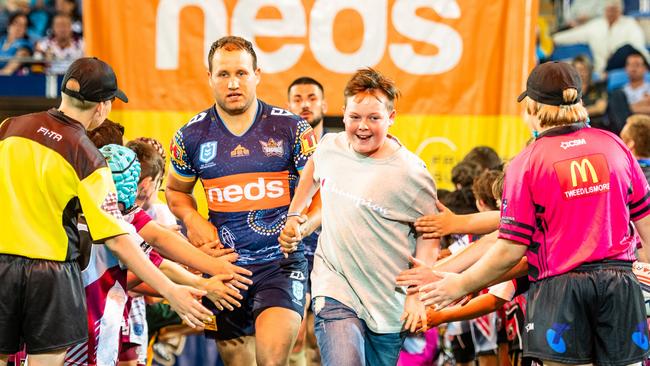
A team can’t fully belong to two places — the Tigers and Dragons are both as good mergers as there can be and even they’re spread thin — but relocation is not abandonment. The Perth Sharks could play two or three games in Cronulla a year. The Wynnum-Manly Sea Eagles could return to Brookvale.
On the other hand, there’s the unfortunate truth of relocation never really being attempted seriously, the furthest a team has moved is from Ashfield to Campbelltown. North Sydney tried to move but due to some appalling luck they never actually played a game at Gosford. The poor, born-to-die Northern Eagles only went half in on the Central Coast at all and abandoned the area after two and a half seasons.
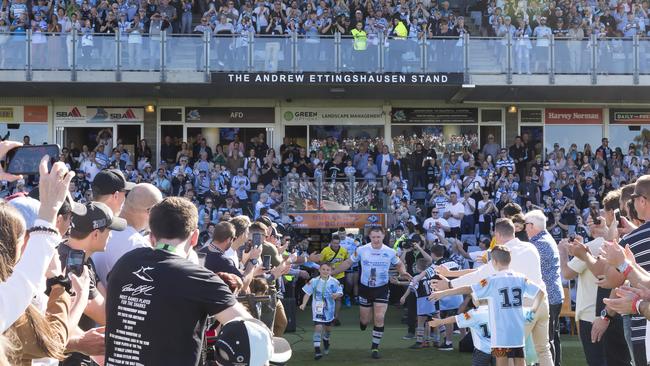
It seems unlikely the NRL will force a team’s hand to relocate. The current doctrine out of head office is teams will not be bailed out by the league once they get into serious financial drama. As such, Manly, who already bought themselves a second life when they sucked the life from North Sydney, and the perpetually broke Sharks — two teams with deep roots in areas that don’t have much growth in them — become juicy targets.
That Super League dream of 10 franchises in 10 different cities and Origin football every week could still come true, but who would stick around to watch? Rugby league could hold onto the old things forever, but who would foot the bill when the money dried up?
It would be a great tragedy if any teams were to leave their ancestral places, and if the Titans were forced to up and move before they’ve really gotten the chance to put down their own roots, but the truth of the matter is this — a choice between relocation and death is no choice at all, and only under true threat of the latter will a club choose the former. `
THE FARAH SITUATION
At the time of writing, Robbie Farah’s status for Sunday’s deathmatch between Cronulla and the Tigers remains unclear but public sentiment does not.
Rugby league people love to tear their idols down and Farah, a man with a complex relationship with the sport’s wider fanbase, is coming under criticism in some corners for being selfish for wanting to play in what could be his final ever rugby league match.
There’s an interesting discussion to be had around why Farah is demonised while others (like Sam Burgess and Cooper Cronk to name a few) were lionised for playing through injury. People can say Farah is trying to make the entire occasion about himself but that’s unfair to him — it’s not selfish to want to be a part of the club’s biggest game in eight years, and it’s definitely not selfish to want to play at least one more time before it’s all over.

I was out at the Tigers in the lead up to the Knights game and although Farah tried to play it down then there was never doubt in my mind he would play. When word came out there was a chance of him doing permanent damage to the cartilage in his knees there was never doubt in my mind he would play. The Sharks are a better side on paper than the Tigers and the Tigers will need to play above themselves to win. They can do that — they’ve been doing it all year — and the unquantifiable boost and inspiration they’ll get from Farah playing, and from the crowd when they realise Farah is playing, is worth just about any trade-off.
SEASON REVIEWS
It’s been a few weeks since we kicked off Season Review Season and this column is already running longer than it should, so let’s knock out three more exhumations as quickly as possible.
New Zealand Warriors
In an effort to move forwards and create a new culture, the Warriors went backwards. Cutting Shaun Johnson was crazy enough on it’s own, replacing him with Kodi Nikorima when Chanel Harris-Tavita was waiting in the wings is just bizarre. Twelve months ago it felt like the Warriors were heading exactly where they needed to be, now it seems like they’re not even sure where they are now. They’re a bad team build on bad choices and Stephen Kearney will come in the firing line next season.

Newcastle Knights
There’s been plenty of Knights chat around these parts in recent weeks and I’ve used this phrase to describe their season before but it still rings true — anybody can knock down a barn, it takes a carpenter to build one.
Penrith Panthers
The Panthers started badly before rallying around a group of young fellas and going on a rollicking run in the middle and back end of the season, only to fall short when it really counted. While the present didn’t quite match the hype, there’s enough foundations laid here to augur an exciting future at the foot of the mountains.
The above could have described every season at Penrith since 2014. Signing James Maloney was supposed to be the move that pushed the Panthers over the top and into the premiership contention so many have predicted for them for so long but his combination with Nathan Cleary never really fired and the can will be kicked further down the road yet again. In 2020, Penrith will find themselves building around an exciting young core with plenty of upside but that’s been the case here before — at some point, the upside has to pay off.

GOLDEN HOMBRE
Is there anything more thrilling than when a big man gets into the clear and attempts an ill-advised dummy, or perhaps a chip kick?
Is there anything greater than when a large lad decides the time has come for him to show the world the ball skills he knows lurk deep within?
Is there anything that lifts the spirit more than a hefty fellow crashing across the stripe for his second NRL try in his 179th first grade match?
I say no, and to honour these big fellas each and every week of the year, which many have dubbed #BigManSeason, we hand out The Golden Hombre, named after Todd Payten, the biggest halfback God ever created.
This week the Hombre shall be cut in two — I simply could not split Scott Bolton banging over a tricky conversion in the dying stages of North Queensland’s win over the Bulldogs and Elijah Taylor scoring an extremely uncertain try against the Dragons.
Dairy Farmers Stadium was Johnathan Thurston’s playground for over a decade and it was the stadium where he became one of the game’s all time greats but I feel confident saying Bolton’s goal was the best one ever kicked at the old ground.
"JUST GO YOURSELF, ELIJAH!" 🤣#NRLDragonsTigers 14-42#TelstraPremiership pic.twitter.com/GZNxs2O6jE
— NRL (@NRL) September 1, 2019
Taylor has long been a favourite of mine but a free-running speed machine he ain’t — the win over the Dragons was just the fourth time in 174 NRL matches he’s gained over 100 metres and a good 40 of his career-high 146 came in the last few minutes, when he threw ten thousand dummies, put Gareth Widdop on skates and looked very unsure about the whole thing. Needless to say, there’s a few punters at Huxley’s in Caringbah who found my reaction to the try over the top — clearly they missed the memo on #BigManSeason.

